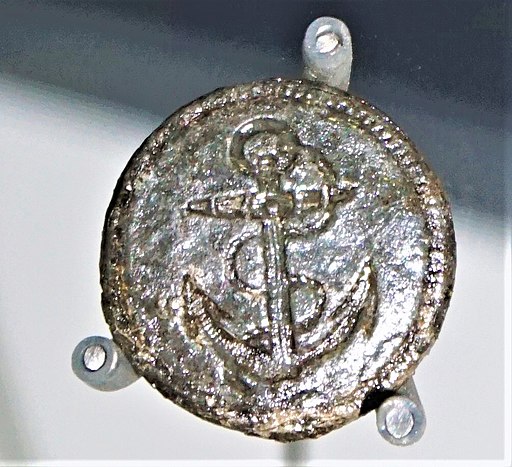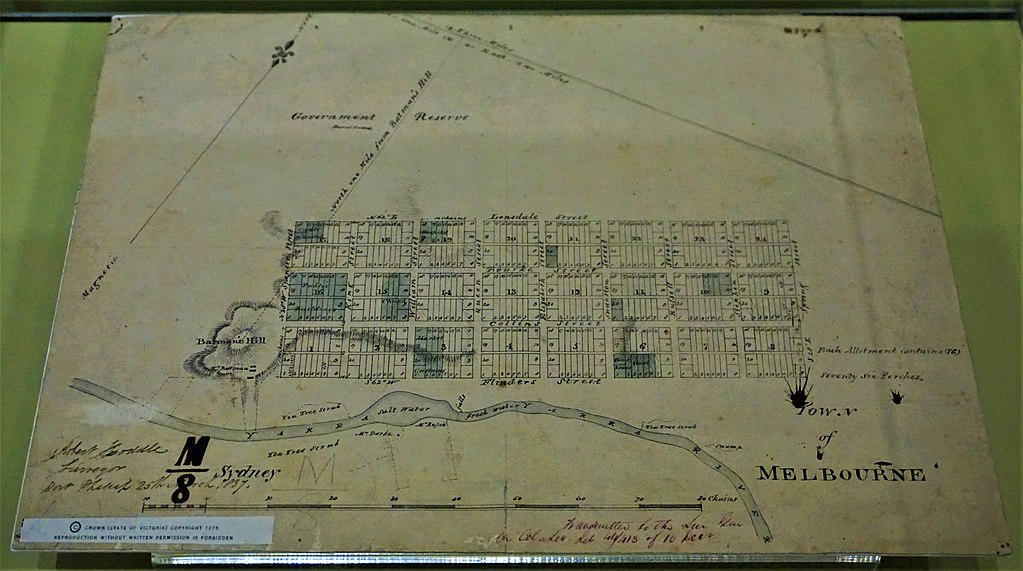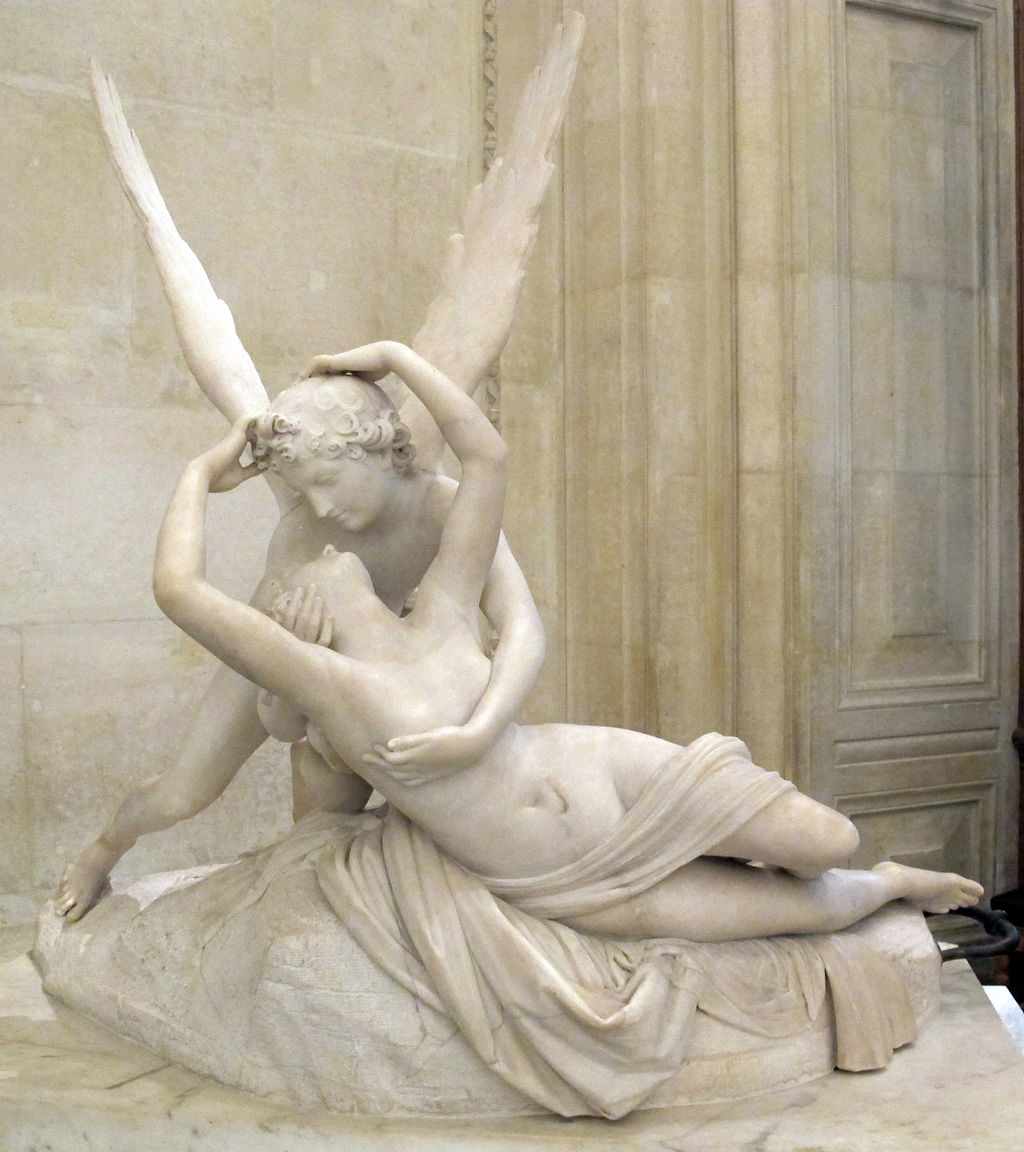
The Old Treasury Building was once home to the Treasury Department of Victoria and is now a museum of Melbourne. The museum focuses on Victoria’s history, the history of Indigenous Victorians, the first white settlement, Ned Kelly, and the Gold Rush.
A Tour of the Old Treasury Building, Melbourne
- Convict Leg Irons, 1803 Sorrento Settlement
- Royal Navy Officer’s Button
- Hoddle’s 1837 Survey of Melbourne
Convict Leg Irons, 1803 Sorrento Settlement

Convict Leg Irons, 1803 Sorrento Settlement
These Convict Leg Irons were found at the site of the 1803 Sorrento Settlement. Thirty years before the founding of Melbourne, Sullivan Bay in Sorrento became the site of Victoria’s first mainland European settlement. Although there was no direct transportation of convicts to Port Phillip, a settlement at Sorrento in 1803, included some 300 male convicts. During the brief occupation, 21 convicts escaped. Little evidence of the short-lived convict settlement in 1803 remains. Four graves, parts of barrels, leg irons, bottles, and other pieces are all that exist.
The site was chosen because of its strategic location near the entrance of Port Phillip Bay. The settlement is significant because it was the first attempt to settle Europeans permanently in what is now Victoria and was a crucial link in the expansion of the colony of New South Wales into Tasmania and Victoria, and the control of Bass Strait as a trade route.
Convicts were also assigned to the early surveyors to assist them in their work. Convict William Buckley escaped from the Sorrento settlement in 1803 and lived with the indigenous people for the next 32 years until he met with John Batman’s party in 1835. These Convict Leg Irons would have been used to control convict movement, in a settlement with no secure prison facilities.
Convict Leg Irons, 1803 Sorrento Settlement
- Title: Convict Leg Irons
- Date: 1800
- Find site: Sorrento, Victoria
- Museum: Old Treasury Building, Melbourne
Royal Navy Officer’s Button

Royal Navy Officer’s Button
This “Royal Navy Officer’s Button” is made of pewter and was found during an archaeological dig at the 1803 Sorrento Settlement site. British Officers of the Royal Navy used these types of buttons as part of their dress uniform.
At first, Royal Navy buttons consisted of white metal pewter, usually with a rose in the center, representing the most famous symbol of the house of Tudor, the Tudor rose. In 1774 a foul anchor surrounded by rope edging took the place of the rose. The rope ‘fouling’ around the anchor was added later. After the Merchant Navy started to use the foul anchor device, a crown was added for all naval officers in 1812. The same basic design remains in use today.
The foul anchor device itself was first used in the seal of the Lord High Admiral of Scotland in 1402. The British Admiralty adopted it for their seal and by many other navies across the world.
Royal Navy Officer’s Button
- Title: Royal Navy Officer’s Button
- Date: 1800
- Material: Pewter
- Find site: Sorrento, Victoria
- Museum: Old Treasury Building, Melbourne
Hoddle’s 1837 Survey of Melbourne

Hoddle’s 1837 Survey of Melbourne
This is “Robert Hoddle’s 1837 Survey of Melbourne”. Surveyor Robert Hoddle was commissioned to design a town plan that was one mile long and half a mile wide. Hoddle designed the main streets 99 feet wide, and each block was serviced by a similarly named ‘little’ street. Thus Melbourne has Collins Street and Little Collins Street parallel to each other.
Robert Hoddle (1794 – 1881) was a surveyor best known as the surveyor-general of the Port Phillip District, which later became known as the Australian state of Victoria. He created what is now known as the Hoddle Grid, the area of the CDB of Melbourne. Hoddle’s survey covered the area from Flinders Street to Lonsdale Street, and from Spencer Street to Spring Street. This grid of streets, laid out when there were only a few hundred settlers, became the nucleus for what is now a city of over 4 million people.
Hoddle was also an accomplished artist and depicted scenes of the Port Phillip region and New South Wales. Hoddle was one of the earliest-known European artists to depict Ginninderra, the area now occupied by Canberra, Australia’s National Capital.
Hoddle’s 1837 Survey of Melbourne
- Title: Robert Hoddle’s 1837 Survey of Melbourne
- Date: 1837
- Material: Paper
- Museum: Old Treasury Building, Melbourne
- Name: Old Treasury Building, Melbourne
- City: Melbourne, Australia
- Established: 2010 (built in 1862)
- Collection: History Museum
- Location: 20 Spring St, Melbourne Victoria, Australia
Explore
- Museums in Australia
- Museums in Melbourne
- Museums in Sydney
~~~
“We are all visitors to this time, this place. We are just passing through.
Our purpose here is to observe, to learn, to grow, to love… and then we return home.”
– Australian Aboriginal saying
~~~
Photo Credit: JOM
Popular this Week








 Sponsor your Favorite Page
Sponsor your Favorite Page SEARCH Search for: Search Follow UsJoin – The JOM Membership Program
Sponsor a Masterpiece with YOUR NAME CHOICE for $5
Share this:
- Tweet
